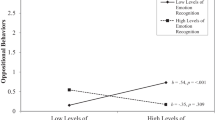Abstract
Display rule behavior and understanding were compared in 72 4- to 6-year-old boys and girls. In Study 1, children listened to stories in which the protagonist was in a positive or in a negative mood. The motivation to hide his or her emotional state was either prosocial or self-centered. Stories with no discrepancy between feeling and expression were included as a control condition. Subjects were asked to identify the protagonist's real feelings and facial expression. Older children were more accurate than younger ones in recognizing that real and apparent emotions did not coincide in the self-centered and prosocial stories. Girls produced more correct answers than boys in the prosocial condition. In Study 2, children were examined in a situation in which they were expected to hide their disappointment about an unattractive gift. They were either observed (social situation) or not observed (nonsocial situation) by the experimenter when receiving the gift. Irrespective of age, preschoolers regulated their nonverbal behavior appropriately in the social situation. The comparison of both data sets revealed that even younger preschoolers follow display rules in their behavior before fully grasping the distinction between real and apparent emotions.
Similar content being viewed by others
References
Aronfreed, J. (1968).Conduct and conscience: The socialization of internalized control over behavior. New York: Academic Press.
Aronfreed, J. (1969). The concept of internalization. In D. A. Goslin (Ed.),Handbook of socialization theory and research (pp. 263–323). Chicago: Rand McNally.
Aronfreed, J. (1976). Moral development from the standpoint of a general psychological theory. In T. Lickona (Ed.),Moral development and behavior (pp. 54–69) New York: Holt, Rinehart and Winston.
Buck, R. (1984).The communication of emotion. New York: The Guilford Press.
Camras, L. A. (1993, March).Facial expressions in context: Contributions to infant emotion theory. Paper presented at the meeting of the Society for Research in Child Development, New Orleans.
Casey, R. J., & Fuller, L. L. (1994). Maternal regulation of children's emotions.Journal of Nonverbal Behavior, 18, 57–89.
Chapman, A. J., Smith, J. R., & Foot, H. C. (1980). Humour, laughter, and social interaction. In P. E. McGhee & A. J. Chapman (Eds.),Children's humour (pp. 141–179). New York: Wiley.
Cole, P. M. (1986). Children's spontaneous control of facial expression.Child Development, 57, 1309–1321.
Ekman, P. (1972). Universal and cultural differences in facial expression of emotion. In J. K. Cole (Ed.),Nebraska Symposium on Motivation, 1971 (pp. 207–283). Lincoln, NE: University of Nebraska Press.
Ekman, P., & Friesen, W. V. (1969a). Nonverbal leakage and clues to deception.Psychiatry, 32, 88–106.
Ekman, P., & Friesen, W. V. (1969b). The repertoire of nonverbal behavior: Categories, origins, usage, and coding.Semiotica, 1, 49–98.
Ekman, P., & Friesen, W. V. (1975).Unmasking the face. Englewood Cliffs, NJ: Prentice-Hall.
Ekman, P., & Friesen, W. V. (1978a).Investigator's guide to the Facial Action Coding System. Palo Alto: Consulting Psychologists Press.
Ekman, P., & Friesen, W. V. (1978b).Manual for the Facial Action Coding System. Palo Alto: Consulting Psychologists Press.
Ekman, P., & Friesen, W. V. (1982). Felt, false, and miserable smiles.Journal of Nonverbal Behavior, 6, 238–252.
Fox, N. A., & Davidson, R. J. (1988). Patterns of brain electrical activity during facial signs of emotion in 10-month-old infants.Developmental Psychology, 24, 230–236.
Fuchs, D., & Thelen, M. H. (1988). Children's expected interpersonal consequences of communicating their affective state and reported likelihood of expression.Child Development, 59, 1314–1322.
Gardner, D., Harris, P. L., Ohmoto, M., & Hamazaki, T. (1988). Japanese children's understanding of the distinction between real and apparent emotion.International Journal of Behavioral Development, 11, 203–218.
Gnepp, J., & Hess, D. L. R. (1986). Children's understanding of verbal and facial display rules.Developmental Psychology, 22, 103–108.
Goodman, L. A. (1969). How to ransack social mobility tables and other kinds of cross-classification tables.American Journal of Sociology, 75, 1–40.
Gross, D., & Harris, P. L. (1988). False beliefs about emotion: Children's understanding of misleading emotional displays.International Journal of Behavioral Development, 11, 475–488.
Halberstadt, A. G., Grotjohn, D. K., Johnson, C. A., Swanson Furth, M., & Greig, M. M. (1992). Children's abilities and strategies in managing the facial display of affect.Journal of Nonverbal Behavior, 16, 215–230.
Harris, P. L. (1989).Children and emotion. The development of psychological understanding. Oxford: Basil Blackwell.
Harris, P. L., Donnelly, K., Guz, G. R., & Pitt-Watson, R. (1986). Children's understanding of the distinction between real and apparent emotion.Child Development, 57, 895–909.
Harris, P. L., & Gross, D. (1989). Children's understanding of real and apparent emotion. In J. W. Astington, P. L. Harris & D. R. Olson (Eds.),Developing theories of mind (pp. 295–314). Cambridge, UK: Cambridge University Press.
Harris, P. L., Guz, G. R., Lipian, M. S., & Man-Shu, Z. (1985). Insight into the time-course of emotion among Western and Chinese children.Child Development, 56, 972–988.
Harris, P. L., Olthof, T., & Meerum Terwogt, M. (1981). Children's knowledge of emotion.Journal of Child Psychology and Psychiatry, 22, 247–261.
Hiatt, S. W., Campos, J. J., & Emde, R. N. (1979). Facial patterning and infant emotional expression: Happiness, surprise, and fear.Child Development, 50, 1020–1035.
Josephs, I. E. (1993).The regulation of emotional expression in preschool children. Münster, New York: Waxmann.
Langeheine, R. (1980).Log-lineare Modelle zur multivariaten Analyse qualitativer Daten [Log-linear models for the multivariate analysis of qualitative data]. Munchen, Germany: R. Oldenbourg Verlag.
Lennon, R., & Eisenberg, N. (1987). Gender and age differences in empathy and sympathy. In N. Eisenberg & J. Strayer (Eds.),Empathy and its development (pp. 195–217). Cambridge, UK: Cambridge University Press.
Lewis, M., Stanger, C., & Sullivan, M. W. (1989). Deception in 3-year-olds.Developmental Psychology, 25, 439–443.
Malatesta, C. Z., & Haviland, J. M. (1982). Learning display rules: The socialization of emotion expression in infancy.Child Development, 53, 991–1003.
Meerum Terwogt, M., & Olthof, T. (1989). Awareness and self-regulation of emotion in young children. In C. Saarni & P. L. Harris (Eds.),Children's understanding of emotion (pp. 209–237). Cambridge, UK: Cambridge University Press.
Miller, P., & Sperry, L. L. (1987). The socialization of anger and aggression.Merrill-Palmer Quarterly, 33, 1–31.
Piaget, J. (1932/1954).Das moralische Urteil beim Kind [The moral judgment of the child]. Zürich, Switzerland: Rascher Verlag (Original work published 1932).
Reissland, N., & Harris, P. (1991). Children's use of display rules in pride-elicting situations.British Journal of Developmental Psychology, 9, 431–435.
Saarni, C. (1982). Social and affective functions of nonverbal behavior: Developmental concerns. In R. S. Feldman (Ed.),Development of nonverbal behavior in children (pp. 123–147). New York: Springer.
Saarni, C. (1984). An observational study of children's attempts to monitor their expressive behavior.Child Development, 55, 1504–1513.
Saarni, C. (1988). Children's understanding of the interpersonal consequences of dissemblance of nonverbal emotional-expressive behavior.Journal of Nonverbal Behavior, 12, 275–294.
Author information
Authors and Affiliations
Additional information
This article is based on a portion of the author's doctoral dissertation. It is dedicated to the author's supervisor, Klaus Schneider, who died in January 1994. The author wishes to thank her second supervisor, Carolyn Saarni, for her many helpful suggestions. Thanks are extended to the children and teachers who participated in this research. Gratitude is also expressed to Monika Rüth for her assistance in data collection and coding.
Portions of these data were presented at the 60th meeting of the Society for Research in Child Development, New Orleans, March 1993.
Rights and permissions
About this article
Cite this article
Josephs, I.E. Display rule behavior and understanding in preschool children. J Nonverbal Behav 18, 301–326 (1994). https://doi.org/10.1007/BF02172291
Issue Date:
DOI: https://doi.org/10.1007/BF02172291




